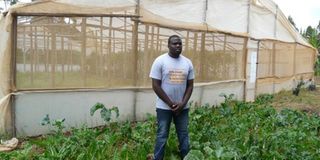From jobseeker to employer: I reap my wealth from tomatoes every week

Mr Muriithi in his farm in Meru. PHOTO | DAVID MUCHUI |
What you need to know:
- 29-year-old Eric Muriithi went into greenhouse farming in 2011 after looking for a job for several years, in vain.
- He sells his tomatoes to traders at Githongo and Gakoromone markets in Meru Town.
The sun casts its bright rays on Githongo Village in Meru County as it slowly rises.
It is about 6.30am and most people are heading to their places of work.
The young ones are going to school, and other older folks to the market, while a good number like Eric Muriithi are heading for their farms.
Muriithi is a greenhouse tomato farmer and plenty of work awaits him. With the help of his four workers he must apply fertiliser in his two greenhouses and weed the crops.
The 29-year-old went into greenhouse farming in 2011 after looking for a job for several years, in vain.
He had completed a diploma course in tourism at NIBS College in Nairobi in 2007. He looked for a job, first in Nairobi, and later in Mombasa.
Frustrated, Muriithi retreated back to his parents’ home in Meru to while away the time as he pondered his next move.
Often, he would go to the markets to visit his friends and scout for opportunities.
It was during one such visit that he saw a farmer deliver boxes of tomatoes to traders and the idea of venturing into farming struck him.
“I saw how he was reaping from farming and vowed to give it a try. And that remains my best decision in life, so far.”
The young man shared the idea with his mother and a sister, who offered him Sh5,000 capital.
His father, on the other hand, gave him fencing material and another of his sisters, who works at Jomo Kenyatta International Airport, Nairobi, bought him polythene covers.
With the help of a friend, Muriithi set out to build a 12 by 30m greenhouse. He used the Sh5,000 to buy 1,000 tomato seedlings worth Sh3,000, Sh1,400 went to nails and the rest to fertiliser.
He planted and waited to get a bumper harvest.
YIELDS DROPPED
His first harvest was good, but the yields dropped, as the crops continued to stay in the greenhouse. They started to wither after six months due to poor quality polythene cover that could not control temperature.
The unfavourable conditions in the greenhouse provided a perfect home for caterpillars and tomato blight disease, which attacked the crops.
“But I was lucky because I did not lose all my crops. I managed to earn about Sh50,000 in three harvests. I was then selling a kilo of tomatoes at Sh70,” he adds.
He used part of the proceeds to buy better quality polythene covers and a net for his greenhouses.
Muriithi then sought training from officials of Syngenta East Africa and Kenya Horticulture Competitiveness Project, which trains farmers.
Together with other farmers, he was trained on various good practices.
“I learned how to plant tomatoes in the nursery, the importance of using quality seeds, materials used in constructing greenhouses, fertiliser and pesticides.”
MASTERED THE ART
Equipped with the skills and having upgraded his greenhouse, he planted 1,000 tomato plants once more, which did well giving him the impetus he needed.
“I have now mastered the art of tomato farming in a greenhouse. I usually plan so that the harvests come after the rains, when a kilo sells at between Sh50 and Sh70.”
He sells his tomatoes to traders at Githongo and Gakoromone markets in Meru Town.
“Tomatoes mature in three months and one harvests for close to a year,” says Muriithi, who now has two greenhouses that host about 1,000 plants each.
Last season, he was harvesting an average of 5,000kg of tomatoes a month from the two greenhouses, bringing his earnings to about Sh250,000.
“Right now I am waiting for the tomatoes to mature. I will start harvesting in a month’s time.”
The farmer plants the Tylka F1 hybrid variety, which offers 60kg per plant per harvest.
“I grow the plants with fertiliser and apply pesticides, particularly when they are flowering because this is when they are prone to diseases,” he says, adding that tomatoes do well in Meru because of the temperature between 20 and 28 degrees Celsius.
He recommends greenhouses to any youth who wants to venture into agribusiness.
“Greenhouses are good for the youth because they make farming appear clean and ‘cool’. Besides, they do not require big land,” he adds.
He advises farmers to use locally available materials that include timber to construct greenhouses.
“The cheapest conventional greenhouse kit, comprising a 500-litre water tank, irrigation drip lines, plastic sheet, seeds and chemicals, costs about Sh200,000, which is unaffordable to many farmers.”
Muriithi intends to increase the tomato crop in his greenhouse from quarter-an-acre to two acres, which he will lease.
“I have bettered my life through farming so much that I have forgotten about looking for a job. I now have a car that I use to transact business.”
Meru Agriculture, Livestock and Fisheries Executive Kaburu M’Ribu said the county government was promoting greenhouse farming to attract more young people into agribusiness.
“Greenhouse farming offers better returns, especially when one grows horticultural produce. Crops such as tomatoes have ready market all-year round.”





